Bulgur: the first convenience food
On a recent trip to Gaziantep, a bustling, vibrant city of 1.8 million people in south-eastern Turkey, I made some astonishing discoveries.
I’d been invited to Gaziantep for the city’s very first Bulgur Festival, a celebration to highlight the city’s recent addition to UNESCO’ s Creative Cities Network for gastronomy.
Described by locals as “yellow gold,” bulgur is one of mankind’s first convenience foods (or food product) with a long history of 4000 years according to some sources, and of over 10,000 years in more recent studies.
Popular in Australia as one of the ingredients in tabbouli/tabbouleh where it is often mistakenly referred to as “cracked wheat,” bulgur is wheat which has been parboiled, dried, ground and then sifted to grade it into different sizes, a process known as “bulguration” which makes it one of the quickest-cooking whole grains.
In fact in many dishes, such as tabbouli/tabbouleh and kisir, its spicy cousin, it needs only to be soaked, not cooked.
Bulgur is made from durum or bread wheat. Bulgur flakes and starch are also manufactured and at the gala dinner held at the Sirehan Hotel in Gazientep, I tasted a delicious sourdough bread made with siyez bulgur from the oldest variety of wheat (Einkorn) still in existence.
“Turkey is home to agriculture and to wheat,” Turkish food writer Aylin Oney Tan told us at the dinner.
“The very first varieties of wheat come from 11,000 -12,000BC and were found near Gaziantep in the Fertile Crescent. It was bulgur, not bread wheat, which was the first-heat processed food. The story of wheat is the story of humankind.”
In Turkey, bulgur is classified according to where it is grown.
At the festival, held over two days in one of Gaziantep’s lovely parks, I was astonished by the different colours (brown, black and yellow) of bulgur available, the different flavours available (flavoured with tomato paste and various spices) and also by the different sizes: coarse bulgur which is used in pilafs, medium bulgur which is used for meatballs and in salads, and fine bulgur which is used in soups, salads and pastries.
Boza, a traditional winter malt drink is also made from bulgur. Thick and pudding-like, it has a sweet, tart flavour.
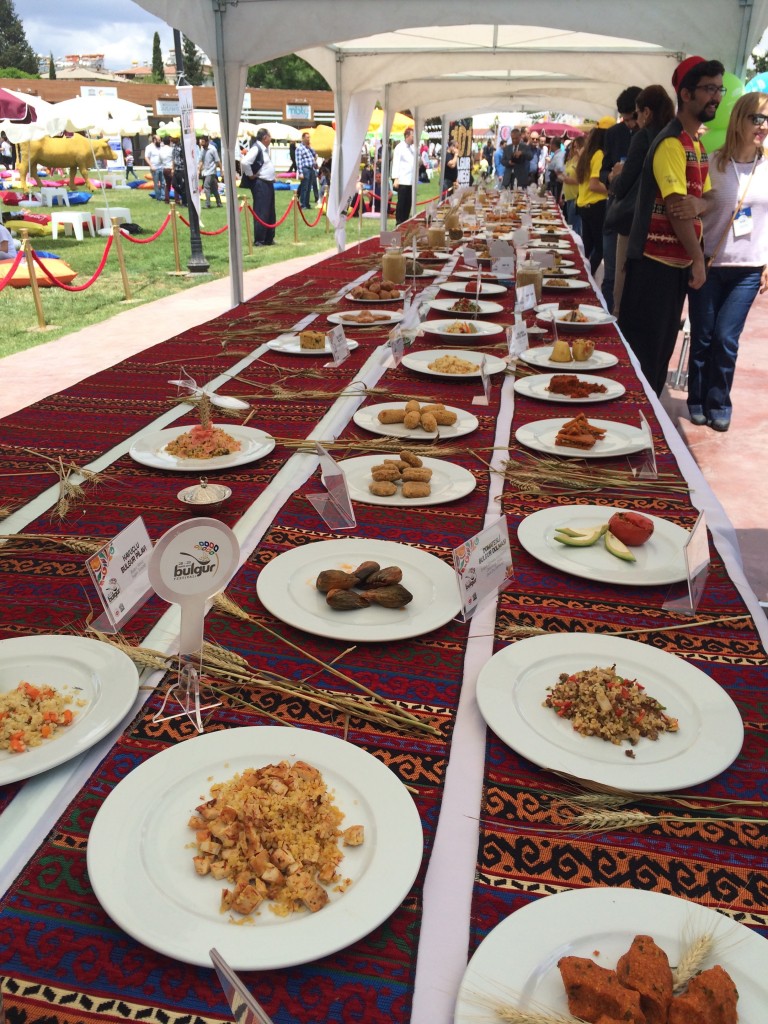 On the first day, a table was set with 101 dishes, showing the many different ways in which this nutritious grain can be prepared. I saw sushi made with bulgur, various vegetables and fruits, including pineapple, stuffed with bulgur, mussels stuffed with bulgur, soups, pilafs and meatballs, a cheesecake made with a bulgur base, halva (a popular Middle Eastern sweet) and even ice cream (which was served at the gala dinner). The dishes had been prepared by students from the Culinary Arts Academy of Istanbul.
The following day, a handful of international chefs demonstrated innovative new ways to substitute coarse bulgur for rice, including a a tasty, delicious Thai green chicken curry with bulgur, chicken biryani, eggplant risotto:
On the first day, a table was set with 101 dishes, showing the many different ways in which this nutritious grain can be prepared. I saw sushi made with bulgur, various vegetables and fruits, including pineapple, stuffed with bulgur, mussels stuffed with bulgur, soups, pilafs and meatballs, a cheesecake made with a bulgur base, halva (a popular Middle Eastern sweet) and even ice cream (which was served at the gala dinner). The dishes had been prepared by students from the Culinary Arts Academy of Istanbul.
The following day, a handful of international chefs demonstrated innovative new ways to substitute coarse bulgur for rice, including a a tasty, delicious Thai green chicken curry with bulgur, chicken biryani, eggplant risotto: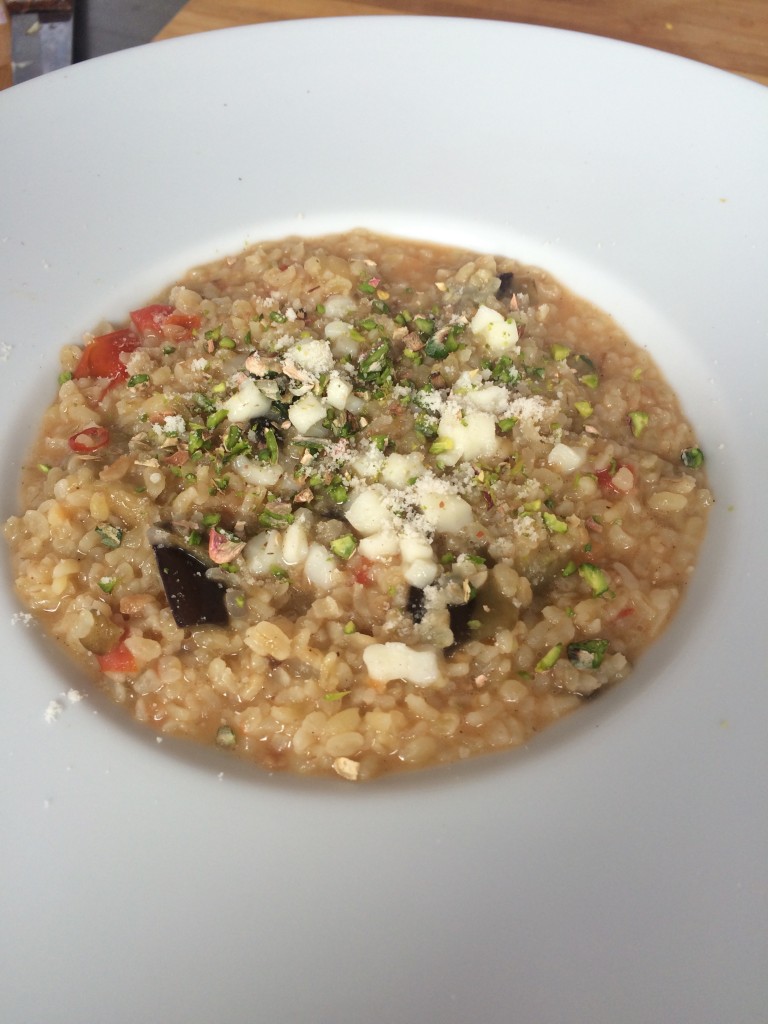 and a sensational Korean bibimbap with eight different vegetables, thinly cut beef and gochujang, a thick sweet spicy red pepper sauce.
“Bulgur is what makes Gaziantep unique,” declared Professor Mustafa Bayram, aka Mr Bulgur.
Twenty years ago he realised there had not been much research conducted about bulgur and chose modern production techniques of bulgur as his Masters’ topic.
“So for my PhD, I wanted to find a new approach and researched the possibilities of soy bulgur, rye bulgur, corn bulgur and chickpea bulgur using the same production techniques as wheat bulgur.,” he told me.
“Wheat bulgur is the most famous at present but I think soy bulgur will become famous in the next ten years because it has a very high protein content.”
For Professor Bayram, bulgur means health.
“It is higher in protein than rice, high in fibre, and rich in B vitamins, iron, phosphorus, calcium and manganese. It should become a mandatory ingredient.”
Manufacturers of burgul are beginning to turn their attention to new ways of marketing, both within Turkey and to foreign countries.
Deniz Goksenin of Metro Market spoke of promoting burgul in the same way as quinoa has been marketed. Smarter ways of packaging were also discussed at one of the seminars.
“Bulgur is easier to prepare and is more nutritious than rice,” said Rudolf van Nunen, a chef from Istanbul. “It’s really good brain food. Young people think it’s not modern or hip and we need to show them modern ways to use it.”
“You mustn’t leave here without going to Gobeklitepe,” declared Osman Serim of MDD Baskani as we were being bused back to the hotel at the end of the festival.
I asked him to write the name in my notebook. Alongside it, he scrawled “first temple of agriculture” and underneath “Zeugma museum.”
“You mustn’t miss these before you go home,” he emphasised.
It was excellent advice. I’d planned to stay on in Gaziantep an extra few days to explore the old city and check out the bazaars and markets.
With help from Filiz Hoskloglu, a culinary consultant and promoter of Gaziantep cuisine, a driver was found and off I went.
Gobeklitepe is a 1 1/2 hour drive south-east of Gaziantep, nor far from the biblical city of Urfa.
There, just 30 years ago, an extraordinary archaeological site of massive carved stones, set out in concentric circles, was discovered, upending the accepted view of the rise of western civilisation.
Arranged and crafted by prehistoric people, the site is 11,000-12,000 years old and predates Stonehenge by some 6,000 years.
Radiocarbon dating indicates agriculture developed here around 10,500 years ago.
As I stood at the top of the hill and looked out over the undulating countryside of parched straw-coloured grasses, I wondered how these megaliths were carved and erected at a time when metal tools had not been discovered, and at the ingenuity of those prehistoric peoples who first thought to process ears of wheat.
and a sensational Korean bibimbap with eight different vegetables, thinly cut beef and gochujang, a thick sweet spicy red pepper sauce.
“Bulgur is what makes Gaziantep unique,” declared Professor Mustafa Bayram, aka Mr Bulgur.
Twenty years ago he realised there had not been much research conducted about bulgur and chose modern production techniques of bulgur as his Masters’ topic.
“So for my PhD, I wanted to find a new approach and researched the possibilities of soy bulgur, rye bulgur, corn bulgur and chickpea bulgur using the same production techniques as wheat bulgur.,” he told me.
“Wheat bulgur is the most famous at present but I think soy bulgur will become famous in the next ten years because it has a very high protein content.”
For Professor Bayram, bulgur means health.
“It is higher in protein than rice, high in fibre, and rich in B vitamins, iron, phosphorus, calcium and manganese. It should become a mandatory ingredient.”
Manufacturers of burgul are beginning to turn their attention to new ways of marketing, both within Turkey and to foreign countries.
Deniz Goksenin of Metro Market spoke of promoting burgul in the same way as quinoa has been marketed. Smarter ways of packaging were also discussed at one of the seminars.
“Bulgur is easier to prepare and is more nutritious than rice,” said Rudolf van Nunen, a chef from Istanbul. “It’s really good brain food. Young people think it’s not modern or hip and we need to show them modern ways to use it.”
“You mustn’t leave here without going to Gobeklitepe,” declared Osman Serim of MDD Baskani as we were being bused back to the hotel at the end of the festival.
I asked him to write the name in my notebook. Alongside it, he scrawled “first temple of agriculture” and underneath “Zeugma museum.”
“You mustn’t miss these before you go home,” he emphasised.
It was excellent advice. I’d planned to stay on in Gaziantep an extra few days to explore the old city and check out the bazaars and markets.
With help from Filiz Hoskloglu, a culinary consultant and promoter of Gaziantep cuisine, a driver was found and off I went.
Gobeklitepe is a 1 1/2 hour drive south-east of Gaziantep, nor far from the biblical city of Urfa.
There, just 30 years ago, an extraordinary archaeological site of massive carved stones, set out in concentric circles, was discovered, upending the accepted view of the rise of western civilisation.
Arranged and crafted by prehistoric people, the site is 11,000-12,000 years old and predates Stonehenge by some 6,000 years.
Radiocarbon dating indicates agriculture developed here around 10,500 years ago.
As I stood at the top of the hill and looked out over the undulating countryside of parched straw-coloured grasses, I wondered how these megaliths were carved and erected at a time when metal tools had not been discovered, and at the ingenuity of those prehistoric peoples who first thought to process ears of wheat.

Table set with 101 different dishes using bulgur, including sushi, cheesecake, stuffed eggplants, artichoke and pineapple
 and a sensational Korean bibimbap with eight different vegetables, thinly cut beef and gochujang, a thick sweet spicy red pepper sauce.
“Bulgur is what makes Gaziantep unique,” declared Professor Mustafa Bayram, aka Mr Bulgur.
Twenty years ago he realised there had not been much research conducted about bulgur and chose modern production techniques of bulgur as his Masters’ topic.
“So for my PhD, I wanted to find a new approach and researched the possibilities of soy bulgur, rye bulgur, corn bulgur and chickpea bulgur using the same production techniques as wheat bulgur.,” he told me.
“Wheat bulgur is the most famous at present but I think soy bulgur will become famous in the next ten years because it has a very high protein content.”
For Professor Bayram, bulgur means health.
“It is higher in protein than rice, high in fibre, and rich in B vitamins, iron, phosphorus, calcium and manganese. It should become a mandatory ingredient.”
Manufacturers of burgul are beginning to turn their attention to new ways of marketing, both within Turkey and to foreign countries.
Deniz Goksenin of Metro Market spoke of promoting burgul in the same way as quinoa has been marketed. Smarter ways of packaging were also discussed at one of the seminars.
“Bulgur is easier to prepare and is more nutritious than rice,” said Rudolf van Nunen, a chef from Istanbul. “It’s really good brain food. Young people think it’s not modern or hip and we need to show them modern ways to use it.”
“You mustn’t leave here without going to Gobeklitepe,” declared Osman Serim of MDD Baskani as we were being bused back to the hotel at the end of the festival.
I asked him to write the name in my notebook. Alongside it, he scrawled “first temple of agriculture” and underneath “Zeugma museum.”
“You mustn’t miss these before you go home,” he emphasised.
It was excellent advice. I’d planned to stay on in Gaziantep an extra few days to explore the old city and check out the bazaars and markets.
With help from Filiz Hoskloglu, a culinary consultant and promoter of Gaziantep cuisine, a driver was found and off I went.
Gobeklitepe is a 1 1/2 hour drive south-east of Gaziantep, nor far from the biblical city of Urfa.
There, just 30 years ago, an extraordinary archaeological site of massive carved stones, set out in concentric circles, was discovered, upending the accepted view of the rise of western civilisation.
Arranged and crafted by prehistoric people, the site is 11,000-12,000 years old and predates Stonehenge by some 6,000 years.
Radiocarbon dating indicates agriculture developed here around 10,500 years ago.
As I stood at the top of the hill and looked out over the undulating countryside of parched straw-coloured grasses, I wondered how these megaliths were carved and erected at a time when metal tools had not been discovered, and at the ingenuity of those prehistoric peoples who first thought to process ears of wheat.
and a sensational Korean bibimbap with eight different vegetables, thinly cut beef and gochujang, a thick sweet spicy red pepper sauce.
“Bulgur is what makes Gaziantep unique,” declared Professor Mustafa Bayram, aka Mr Bulgur.
Twenty years ago he realised there had not been much research conducted about bulgur and chose modern production techniques of bulgur as his Masters’ topic.
“So for my PhD, I wanted to find a new approach and researched the possibilities of soy bulgur, rye bulgur, corn bulgur and chickpea bulgur using the same production techniques as wheat bulgur.,” he told me.
“Wheat bulgur is the most famous at present but I think soy bulgur will become famous in the next ten years because it has a very high protein content.”
For Professor Bayram, bulgur means health.
“It is higher in protein than rice, high in fibre, and rich in B vitamins, iron, phosphorus, calcium and manganese. It should become a mandatory ingredient.”
Manufacturers of burgul are beginning to turn their attention to new ways of marketing, both within Turkey and to foreign countries.
Deniz Goksenin of Metro Market spoke of promoting burgul in the same way as quinoa has been marketed. Smarter ways of packaging were also discussed at one of the seminars.
“Bulgur is easier to prepare and is more nutritious than rice,” said Rudolf van Nunen, a chef from Istanbul. “It’s really good brain food. Young people think it’s not modern or hip and we need to show them modern ways to use it.”
“You mustn’t leave here without going to Gobeklitepe,” declared Osman Serim of MDD Baskani as we were being bused back to the hotel at the end of the festival.
I asked him to write the name in my notebook. Alongside it, he scrawled “first temple of agriculture” and underneath “Zeugma museum.”
“You mustn’t miss these before you go home,” he emphasised.
It was excellent advice. I’d planned to stay on in Gaziantep an extra few days to explore the old city and check out the bazaars and markets.
With help from Filiz Hoskloglu, a culinary consultant and promoter of Gaziantep cuisine, a driver was found and off I went.
Gobeklitepe is a 1 1/2 hour drive south-east of Gaziantep, nor far from the biblical city of Urfa.
There, just 30 years ago, an extraordinary archaeological site of massive carved stones, set out in concentric circles, was discovered, upending the accepted view of the rise of western civilisation.
Arranged and crafted by prehistoric people, the site is 11,000-12,000 years old and predates Stonehenge by some 6,000 years.
Radiocarbon dating indicates agriculture developed here around 10,500 years ago.
As I stood at the top of the hill and looked out over the undulating countryside of parched straw-coloured grasses, I wondered how these megaliths were carved and erected at a time when metal tools had not been discovered, and at the ingenuity of those prehistoric peoples who first thought to process ears of wheat.



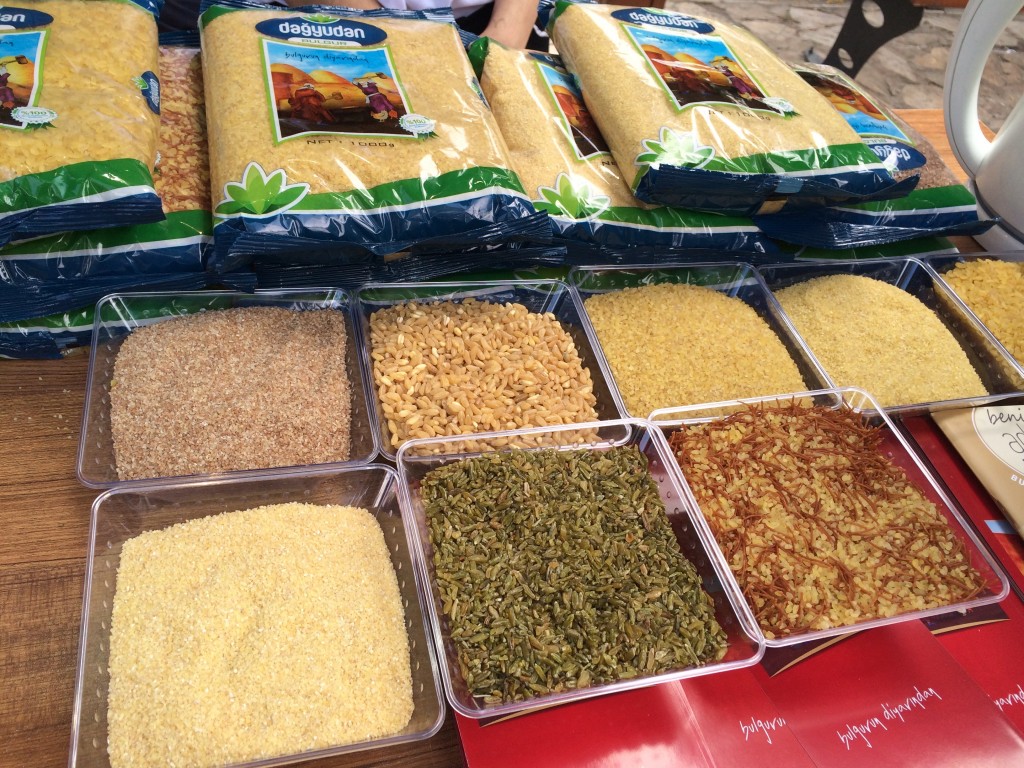
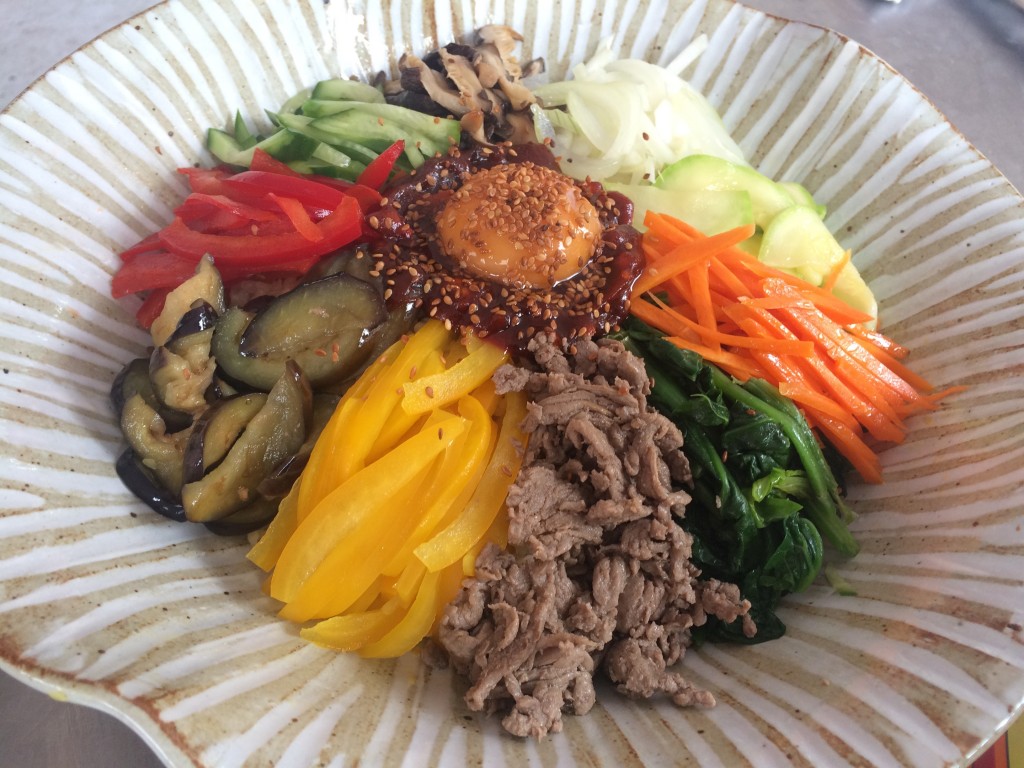
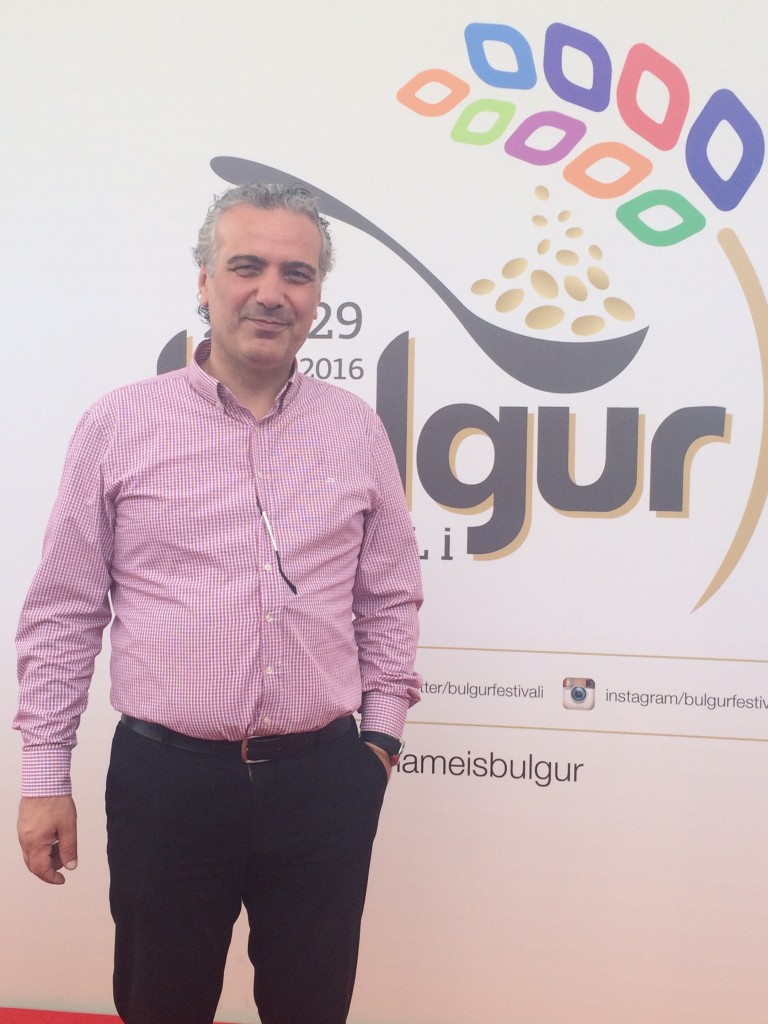
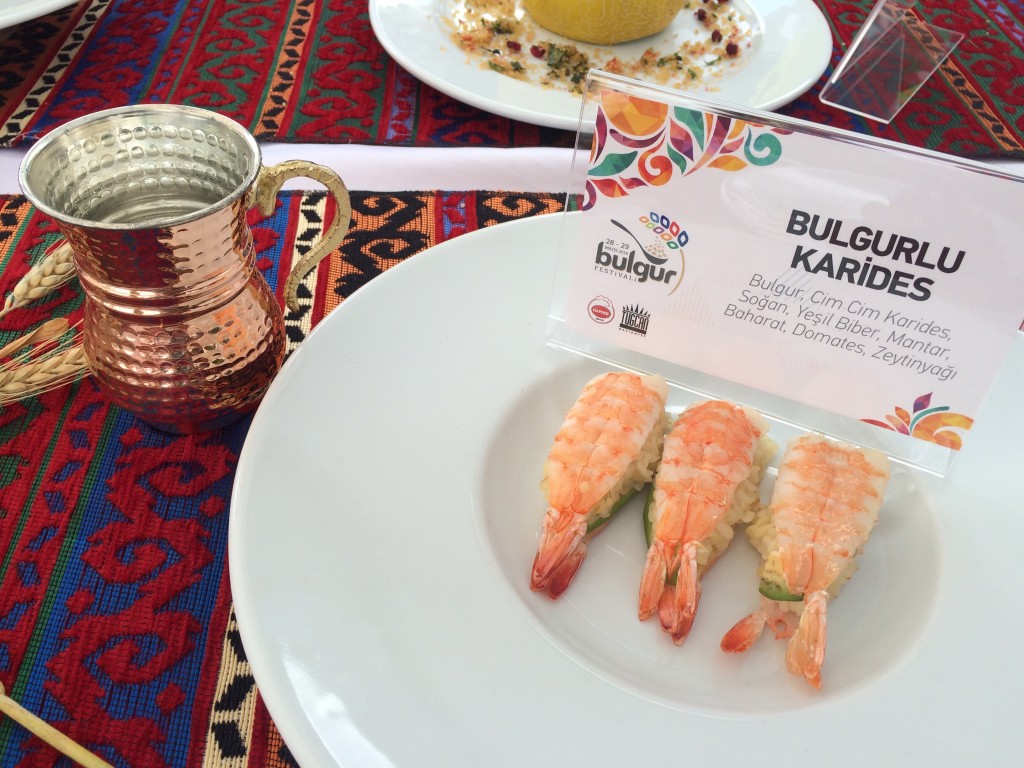
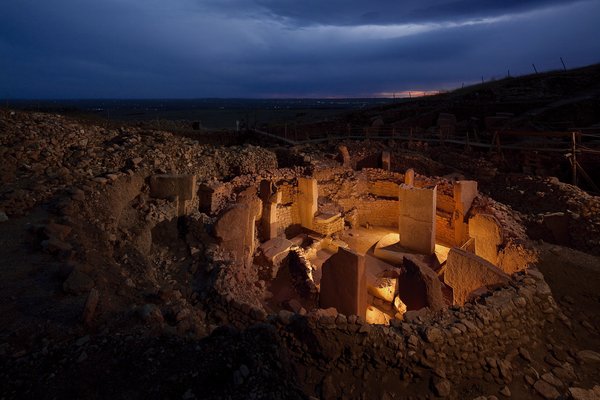
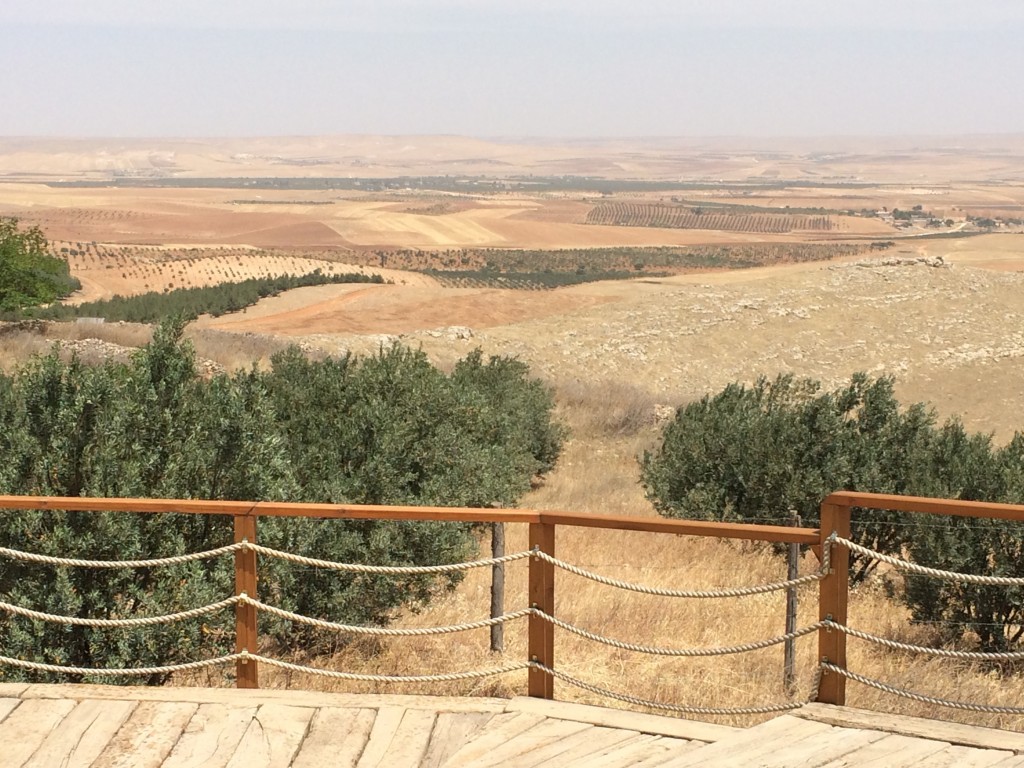
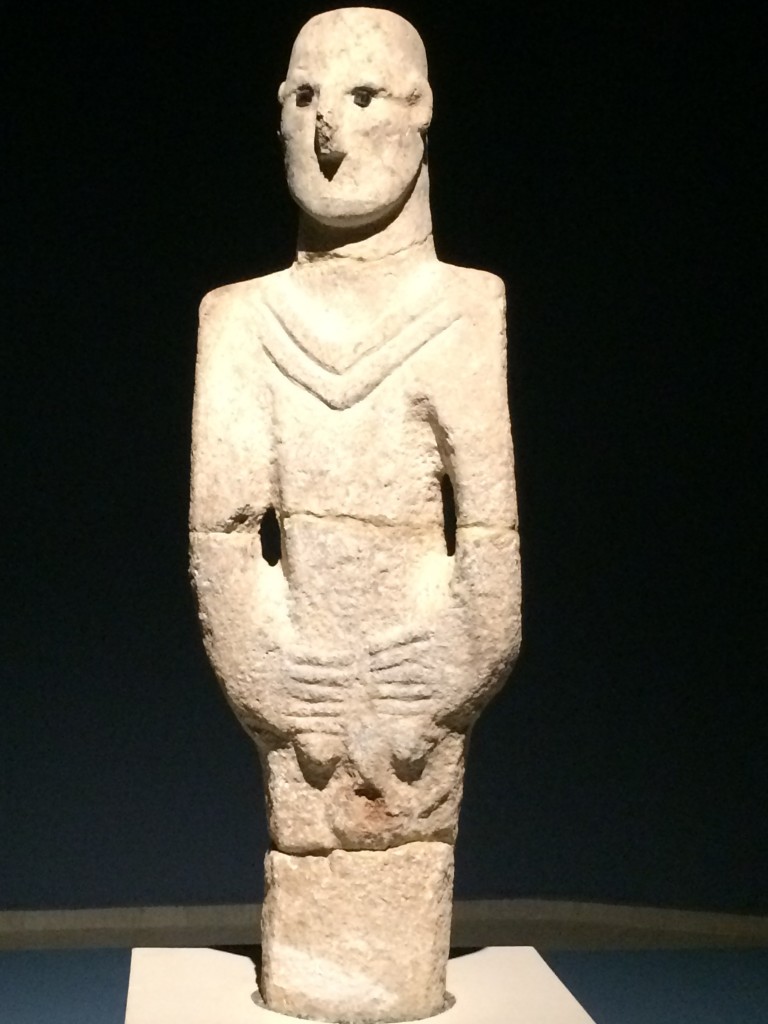
Your coverage of the bulgur festival is fascinating and thorough. It was a remarkable event.
Thank you Barbara – I really appreciate such positive feedback from a professional like you.
Sheridan